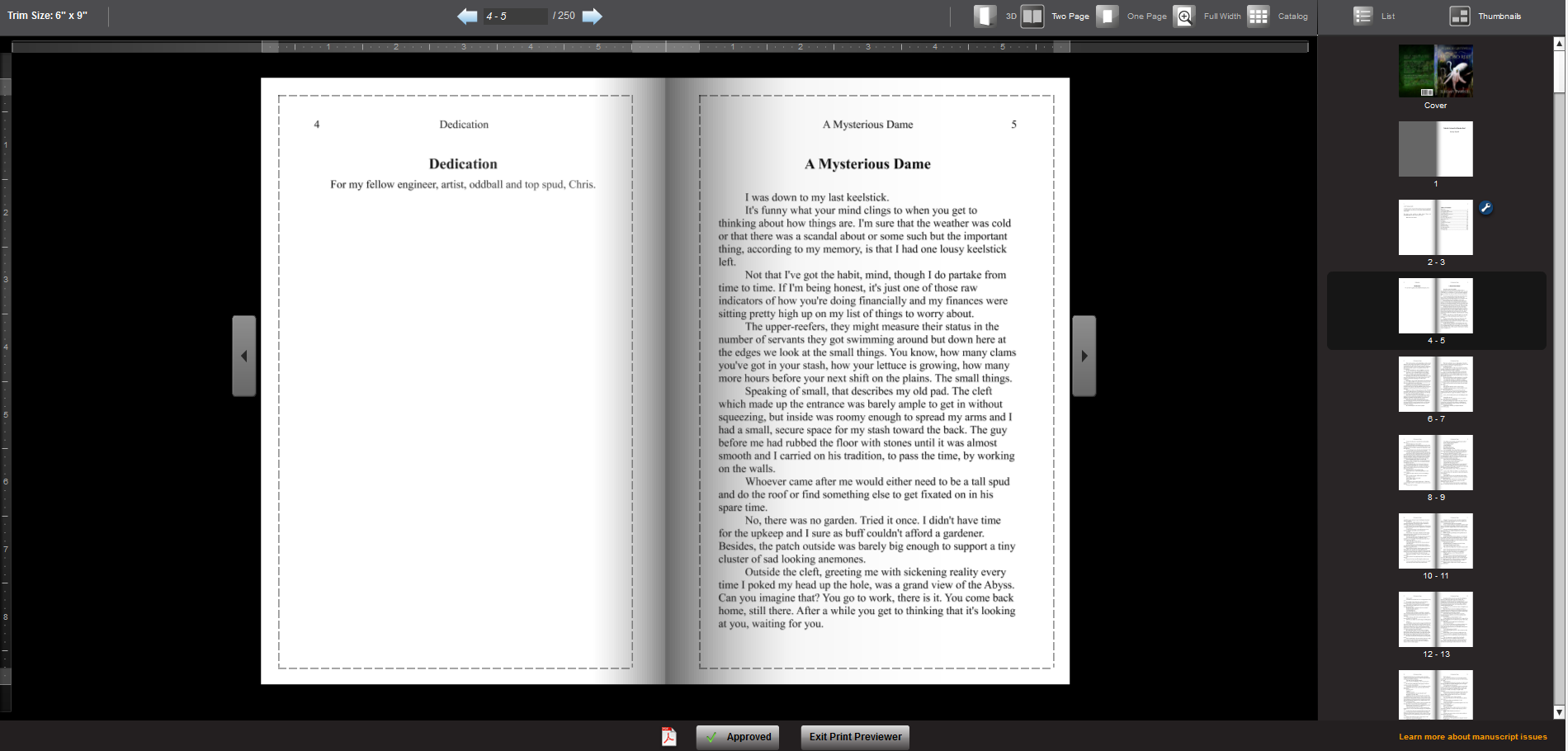Last post I uploaded the front cover to the KDP creator. I had blundered in that the DPI or dots per inch setting was at a default of 72, rather than the required 300. Changing the DPI to 300, re-exporting to PDF and then uploading resulted in the following:

Check through the list on the right. The markup within the table of contents was removed, without affecting the table, so that’s fine. Also, it asks you double check the Author, ISBN and Title. Good idea. Do that. Character for character.
Hey, there’s even a 3D view:

Woohoo! Looks pretty good. The automatic whatsit that Amazon has going stopped complaining about the size of the PDF since it now closely matched the dimensions of the book itself.
You can look through the pages, and I would strongly encourage you to. Why? Because the PDF you uploaded will not be what gets used. Observe:

If you look closely, the border closer to the spine is greater than the border against the edge. I used a 1cm border in the PDF, Amazon has automatically added in an extra padding on the spine. This is a good thing, since it will mean the words aren’t squished into the paper-fold.
I can’t guarantee it, but after playing with it for a bit (doing a few uploads to get it ‘just right’), I think that the engine is smart enough to recognise page changes and update the table of contents accordingly. Even so, check that each chapter in the TOC matches the actual page for the Chapter. It’s a small task that will save you having to apologise to your readers for a dodgy TOC.
Once I was happy with it, I hit the ‘Approve’ button. Click
Ahh.
So life is grand, right? I’ve uploaded the manuscript, I’ve uploaded the front cover as a PDF, it’s looking pretty much how I want it, all I need to do now is order a proof.
What’s a Proof?
Electronic eBooks are cool because, hey, what you see is what you get. You can pop your ePub or PDF or mobi file onto your favourite reader and have a look-see to make sure it’s all fine and dandy like cotton candy. Of course, different readers with different dimensions will display things differently, but you can rest easily knowing that the software does a best effort to make stuff look and read properly.
Not so with printed books. Paper ain’t that advanced.
And while PDFs are fantastic for viewing something as a bunch of pages, the conversion to a hardcopy means extra padding on the inside of each page, a few extra pages added for the actual printing house and physical constraints applied because of the thickness of paper, the stock used, etc.
In other words, once you’ve done all the work uploading your masterpiece, you need to order a proof to make sure that it – it being the actual book what gets pumped out by the presses and will land into the laps of your audience – looks and feels and even smells like you want it.
Yes, smells. There actually is a difference in smells between books. I’m not sure if it’s the cover or the paper or a combination or just something in the manufacturing process, but there certainly is a smell associated with a new book.
Lulu strongly encourages ordering a proof. They will not allow you to use Global Reach without you having ordered and actually looked at a copy of your book. For this, they will let you order it at cost price.
I personally make a habit of buying at least two so I can keep one and give one away as a present.
What about Amazon? No. You cannot purchase a proof, even though you own the book.
Say what?
Let me clarify: There is no facility for ordering a proof at cost price. You will pay the full price of your book.
But… but I made the damn thing!
I know, I know. Believe me, I know. It’s yours. You did it. You made it. Why do you have to sell it to yourself?
It turns out Create Space, by itself, does allow author copies. And while Amazon uses Create Space to manage your hardcopies, it does not allow you to purchase author copies.
So what happens if you wanted to print off, say, 1,000 copies and distribute them yourself in a vanity-publishing style venture? You’re up for either ordering the 1,000 copies at full price or temporarily discounting the book to cost, ordering, then raising the price back up. Either way, it’s ugly.
This is a two-sided story. Personally I believe that author copies should be allowed, and encouraged, and even enforced like Lulu does. I can see, though, that purchasing your own book at full price does affect the ranking of the book, and rightly so. A purchase is a purchase, regardless of who made the original purchase.
And before you ask, no, I’m not an expert on how Amazon does the rankings. I’m sure it’s time based and it’s also categorically based – that is, you have different rankings for different categories – but as for how the numbers get calcumalated, I can only say that more sales -> better rank.
Also, depending on the royalty rate, you’ll get some of the money you spent back. Icky, I know, but maybe it’s Amazon’s way of avoiding rank-diddling by someone with a hefty cashroll. Eh. Dunno.
So, after all of that, I picked up my credit card, and ordered my own book. You won’t believe what happened next!
Nah, you prolly will.


[…] doing all the setup and tweaking and uploading and tweaking again, I got to the point where I could actually submit the book for […]